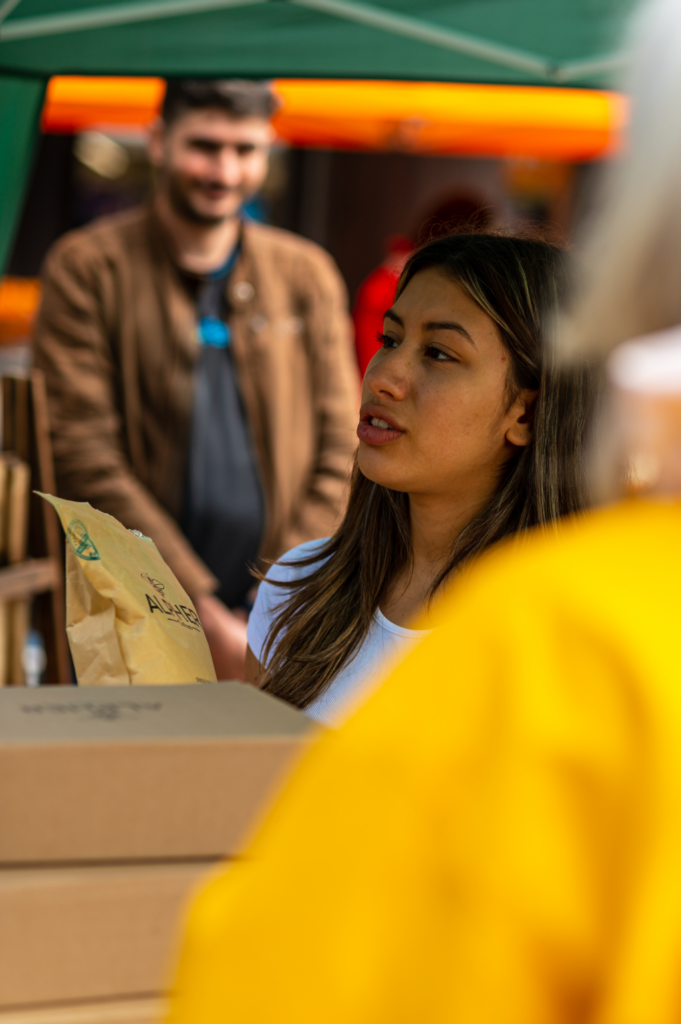I spent the day on Saturday helping out at an artisan market in our village.
Cranleigh’s Surrey Hills Artisan Market is a collaboration between Cranleigh Chamber of Commerce (where I’m Vice President) and Surrey Hills Enterprises.
Each month, the market brings a range of local artisan businesses to our High Street, introducing residents and visitors to quality products.
When we ran the first artisan market last month, footfall in the High Street rose by 26.9% compared to the previous Saturday, making the event highly beneficial to our High Street retailers.
I’m a big fan of local marketing.
One of the drivers behind our relaunch as Bear Content earlier this year was to focus on local businesses, providing our content production services to small businesses in the Surrey Hills.
Local marketing just makes sense.
The pandemic changed our shopping and leisure preferences, with a renewed focus on local activity.
Increasing pressure from the government through transport policy to address the climate crisis is likely to encourage all of us to spend more time closer to home.
From a business perspective, it makes a great deal of sense to do business locally too.
Rather than wasting time and fuel driving around the country working with clients, or looking for customers, it is far more efficient to serve those on your doorstep.
It’s easier too!
Local marketing allows your budget to stretch that much further, so you can elevate your brand with a local target audience rather than spreading your marketing message too thinly.
Here are six ways to make the most of your local marketing.
1 – Use local photography
Photography is a powerful way to promote your local business.
Use high-quality photography that represents your brand, products and services to enhance local search results.
Rather than falling back on the overused city skylines so often seen on websites from businesses that seek to look bigger than they truly are, think local.
If a local customer sees local photography on your website, social media and search results, they are that much more likely to get in touch.
2 – Make the most of your physical presence
If you have a physical shop or office location, flaunt it!
We live in a world where work is increasingly happening remotely.
Many of us are still working from home or visiting the office on a day or two each week.
In this new, remote-first world, a physical location can offer a marketing advantage.
From a branding perspective, your shop or office suggests stability and longevity.
Make the most of any physical presence by introducing branding elements to the exterior and interior design.
At a bare minimum, invest in quality signage to display your logo.
3 – Google My Business
When prospective customers search for your business, the most important search result in Google comes courtesy of the Google My Business listing.
Google My Business is a free business profile with various tools designed to promote your local business in search results and on Google Maps.
I know one dry cleaner in London who optimised his Google My Business listening so expertly that customers landing at Heathrow Airport would drive 30 minutes across town to use his business.
Once you have claimed your listing, make sure you keep it up to date.
Add your opening hours, quality photographs, a virtual tour of your premises, and (this is possibly the most critical factor) ask customers for reviews.
In our experience, the more 5-star reviews that are attached to your Google My Business listing, the better it will perform in local searches.
4 – Build connections with other local businesses
Every village and town across this country has a thriving local business community.
In 1794, Napolean described England as a “nation of shopkeepers”, referring to remarks made by Adam Smith in The Wealth of Nations.
This description of hard-working, local, small-scale productive businesses that provide jobs and serve their communities made Britain the envy of the world.
To find like-minded local businesses, you can join your local Chamber of Trade or find networking groups.
There is also an argument for knocking on doors!
We’ve got a brilliant family-owned bakery in Cranleigh. The proprietor is well known for his cheeky appearances on social media, dropping off baked gifts to other High Street businesses or involving them in his competitions.
With the pandemic experience (hopefully) behind us, there is a great deal of appetite to meet people again.
5 – Get your hands dirty
When building your local presence, it’s tempting to sponsor some events.
Communities have village fetes and dog shows, always in need of sponsorship.
Rather than throwing money at local events and getting your brand plastered across them in return, consider offering your people power too.
What local groups often need is hard-working, experienced people who can organise events, sell tickets and move things around on the day.
While local organisations will welcome your sponsorship money too, the best local marketing you can do is to get your hands dirty and make a positive contribution to your community.
6 – Run local Facebook Ads
For local marketing, Facebook Ads allow you to target people in a specific geographical location easily.
Set the radius from your business and let the Facebook algorithm to the rest.
You can run ads to raise awareness of your brand or to offer a discount or other incentive.
One of my favourite things about Facebook Ads is the ability to turn your advertising on or off, depending on the circumstances.
If you’re experiencing a quiet day in the shop, throw some money behind your Facebook Ads that day to drive more customers to your door.
And if things are getting busy, turn the ads off for a bit.
An essential component in long-term Facebook Ad success is retargeting your website visitors and existing customers.
Make sure you add the Facebook Pixel to your website to advertise to website visitors in the future and always collect your customers’ email addresses. Hence, you tell Facebook to present them with ads and offers in the future.
With a decent-sized customer email list, you can also create lookalike audiences on Facebook and run ads to prospective customers with similar attributes.
***
We’ve seen the rise of local marketing in recent years, and it doesn’t look like that trend is going anywhere.
With so many people turning to the Internet and social media for their buying needs, supporting local marketing with digital techniques has become more important than ever before.
Have you tried any or all the six techniques described in this blog post?
What other strategies have helped drive sales through your location-based strategy?
Let us know what works best for you by reaching out today!




